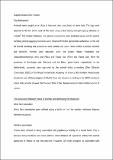Files in this item
Marine mammals trace anthropogenic structures at sea
Item metadata
| dc.contributor.author | Russell, Deborah Jill Fraser | |
| dc.contributor.author | Brasseur, Sophie | |
| dc.contributor.author | Thompson, David | |
| dc.contributor.author | Hastie, Gordon Drummond | |
| dc.contributor.author | Janik, Vincent M. | |
| dc.contributor.author | Aarts, Geert | |
| dc.contributor.author | McClintock, Brett Thomas | |
| dc.contributor.author | Matthiopoulos, Jason | |
| dc.contributor.author | Moss, Simon | |
| dc.contributor.author | McConnell, Bernie J | |
| dc.date.accessioned | 2014-10-20T11:01:05Z | |
| dc.date.available | 2014-10-20T11:01:05Z | |
| dc.date.issued | 2014-07-21 | |
| dc.identifier | 118393993 | |
| dc.identifier | 8bac775d-643d-4f94-a07d-6eace67201c2 | |
| dc.identifier | 84904916488 | |
| dc.identifier | 000339465900005 | |
| dc.identifier.citation | Russell , D J F , Brasseur , S , Thompson , D , Hastie , G D , Janik , V M , Aarts , G , McClintock , B T , Matthiopoulos , J , Moss , S & McConnell , B J 2014 , ' Marine mammals trace anthropogenic structures at sea ' , Current Biology , vol. 24 , no. 14 , pp. R638-R639 . https://doi.org/10.1016/j.cub.2014.06.033 | en |
| dc.identifier.issn | 0960-9822 | |
| dc.identifier.other | ORCID: /0000-0002-1969-102X/work/49052031 | |
| dc.identifier.other | ORCID: /0000-0002-9773-2755/work/54819209 | |
| dc.identifier.other | ORCID: /0000-0001-7575-5270/work/56052224 | |
| dc.identifier.other | ORCID: /0000-0003-1546-2876/work/56862211 | |
| dc.identifier.other | ORCID: /0000-0001-7894-0121/work/60427865 | |
| dc.identifier.uri | https://hdl.handle.net/10023/5560 | |
| dc.description | D.J.F.R., G.H., V.M.J., S.E.W.M. and B.M. were funded by the UK Department of Energy and Climate Change (DECC) as part of their Offshore Energy Strategic Environmental Assessment programme. The tags and their deployment were funded by GSP, NUON, RWE, Eneco and Gemini, DECC, Natural Environment Research Council, Scottish Natural Heritage and Marine Scotland. | en |
| dc.description.abstract | On land, species from all trophic levels have adapted to fill vacant niches in environments heavily modified by humans (e.g. [1]). In the marine environment, ocean infrastructure has led to artificial reefs, resulting in localized increases in fish and crustacean density [2]. Whether marine apex predators exhibit behavioural adaptations to utilise such a scattered potential resource is unknown. Using high resolution GPS data we show how infrastructure, including wind turbines and pipelines, shapes the movements of individuals from two seal species (Phoca vitulina and Halichoerus grypus). Using state-space models, we infer that these animals are using structures to forage. We highlight the ecological consequences of such behaviour, at a time of unprecedented developments in marine infrastructure. | |
| dc.format.extent | 2 | |
| dc.format.extent | 772770 | |
| dc.format.extent | 232519 | |
| dc.language.iso | eng | |
| dc.relation.ispartof | Current Biology | en |
| dc.subject | QH301 Biology | en |
| dc.subject | QL Zoology | en |
| dc.subject | NERC | en |
| dc.subject | BEIS/DECC | en |
| dc.subject | BDC | en |
| dc.subject | R2C | en |
| dc.subject | SDG 14 - Life Below Water | en |
| dc.subject.lcc | QH301 | en |
| dc.subject.lcc | QL | en |
| dc.title | Marine mammals trace anthropogenic structures at sea | en |
| dc.type | Journal article | en |
| dc.contributor.sponsor | NERC | en |
| dc.contributor.sponsor | NERC | en |
| dc.contributor.institution | University of St Andrews. School of Biology | en |
| dc.contributor.institution | University of St Andrews. Marine Alliance for Science & Technology Scotland | en |
| dc.contributor.institution | University of St Andrews. Scottish Oceans Institute | en |
| dc.contributor.institution | University of St Andrews. Centre for Research into Ecological & Environmental Modelling | en |
| dc.contributor.institution | University of St Andrews. Sea Mammal Research Unit | en |
| dc.contributor.institution | University of St Andrews. Institute of Behavioural and Neural Sciences | en |
| dc.contributor.institution | University of St Andrews. Centre for Social Learning & Cognitive Evolution | en |
| dc.contributor.institution | University of St Andrews. Bioacoustics group | en |
| dc.identifier.doi | https://doi.org/10.1016/j.cub.2014.06.033 | |
| dc.description.status | Peer reviewed | en |
| dc.identifier.grantnumber | NE/J004243/1 | en |
| dc.identifier.grantnumber | Agreement R8-H12-86 | en |
This item appears in the following Collection(s)
Items in the St Andrews Research Repository are protected by copyright, with all rights reserved, unless otherwise indicated.


